#Zazzle also happens to have a sale going on today
Explore tagged Tumblr posts
Text


Potion of Wakefulness DnD inspired mug
Every day is an adventure, whether you're playing a long DnD session or just getting through the day, this is just the pick-me-up you need.
Available in: 11oz standard mug ; 20oz jumbo mug; 12 oz latte mug; 17oz latte mug; 15oz mug; 6oz espresso mug; 10oz bone china mug; 12oz insulated tumbler.
The oz listed in the design are edited for each size, so if you choose to edit design for colors, please make sure you start with the size you want to order :)
If you're more of a WOW nerd than a DnD nerd, check out the Epic Tea Mug here.
Text of mug ID'd under the cut
Potion of Wakefulness
Potion, Common, Healing, Consumable
Weight: x oz
A character who drinks the magical fluid in this vial reduces their exhaustion level by 1. The potion's liquid releases a pleasant aroma when agitated.
#I got an idea today and ran with it#Zazzle also happens to have a sale going on today#art#mugs#dnd#potion#potion of wakefulness#kpyl#kinetic-passion#kineticpassion#my designs#zazzle
7 notes
·
View notes
Text
so I saw @drowsymanatee‘s fish timeline and saw a few other people do theirs as well and since I have a similar “started from the bottom” type timeline, here we go
Under a cut because large images lol
Age 5+
My first childhood fish and first real pet was a comet goldfish won at a fair when I was very young. Obviously the care was mostly in the hands of my mom and she did decently well for the fish, I think. At first, he lived in a small one gallon tank with another goldfish and a bunch of guppies (not the fancy kind... just regular guppies). I have a picture of that somewhere but can’t seem to find it currently. But eventually, he got moved into a 55 gallon with various other goldfish and it turned out he was actually a decently fancy veiltail and he turned completely white and lived ~8 years and maxed at ~8 inches long in the body, nearly a foot with his tail included. He should have been in a pond and the tank was way overstocked with fancies and single tails with nowhere near enough filtration.


Age ~12?
I also had a fish that was “mine” for a while who lived in a 10 gallon tank outside my bedroom that I called “Neighbor Fish” that I think was actually a silver dollar. My mom had tried to set up a tropical community with fish her friend didn’t want anymore and Neighbor Fish was an asshole to the other fish (I don’t blame him) so got separated and lived in the 10 gallon until his heater malfunctioned one day and cooked him. No pictures but I technically was in charge of him for a while and would feed him (but didn’t do water changes) Poor dude.
Age 19
In the beginning of my sophomore year at college, my ex and I decided to get two betta fish together. We kept them in one of those terrible 1/2 gallon “tanks”. They were named Michael and Lucifer because we thought we were clever lol
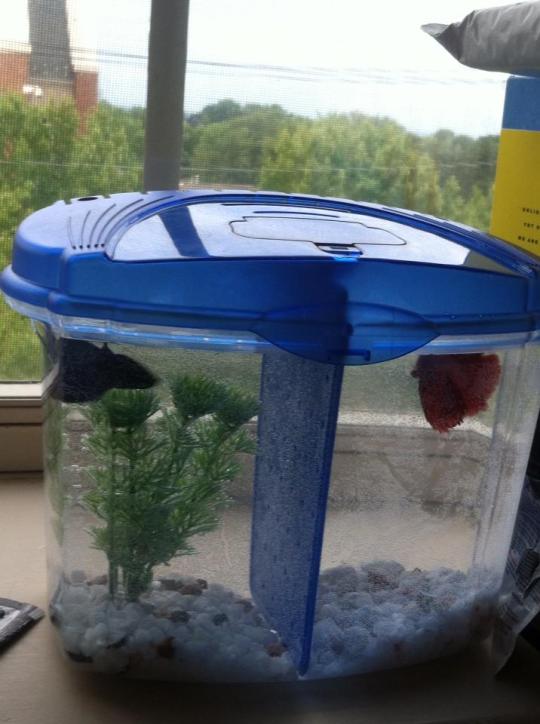
My suitemate who kept a betta in a heated, filtered 5 gallon told me it wouldn’t work longterm and I’d need a heater at least, so I got one of those but didn’t get a bigger tank. Yeah, needless to say, Lucifer passed within a month and Michael looked like this:

He clearly has fin rot in this picture and is underweight, stress stripey and just awful looking but I had no clue. I was distracted by my friends and by my relationship and I did do a 100% water change every week or so, but mostly I didn’t pay attention to Michael at all... eventually, I got him an “upgrade” into a 1 gallon tank with a bubbler from Petco that was on sale... and then second semester sophomore year, my friend went abroad, my ex was busy with rushing a frat and I had more free time... and that’s when the special interest level of fish research began.
First “real” tank, February 2014

I upgraded Michael to a heated, filtered 2.5 gallon after reading a lot on betta forums. I was taking a break from tumblr at the time but I eventually came back on tumblr that summer and discovered fishblr.
Soon, Michael looked like this:

I was really getting fond of him and the difference was incredible.
Second tank, March 2014
Within a month I got a 5.5 gallon tank and a second betta named Kaiju. It was hideous and had bright blue gravel and didn’t have a lid for a long time.

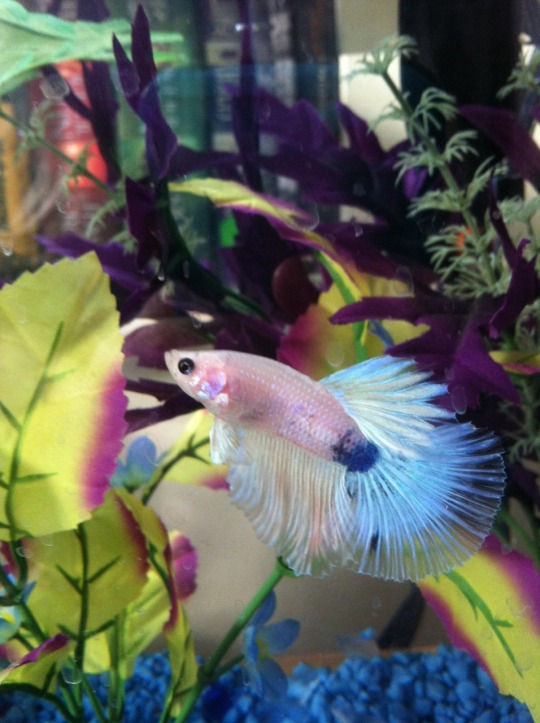
First divider attempt, 3rd fish
So yeah, like an idiot, I tried to divide the 5.5 gallon tank with a craft mesh divider. Didn’t go so well, both fish were very stressed and I returned my third fish, Kenway, but actually went back and rebought him a few weeks later.
And promptly panicked thinking my parents would hate me for having three fish tanks (lol in retrospect this is hilarious), so Kenway lived with my boyfriend for the summer and got less than stellar care.

Third tank, 4th fish
So as soon as I got home for the summer, I promptly got a third fish anyway... I had never seen a plakat betta in person before and the majority of fish I’d seen were not that interesting color-wise either and Odysssey was just... a dream. He lived in a 1.5 gallon Tetra cube which I actually really liked the look of... but was far too small.
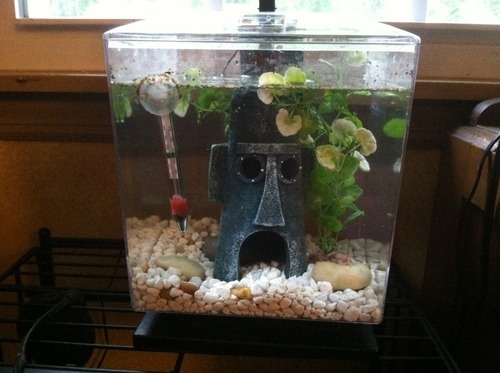
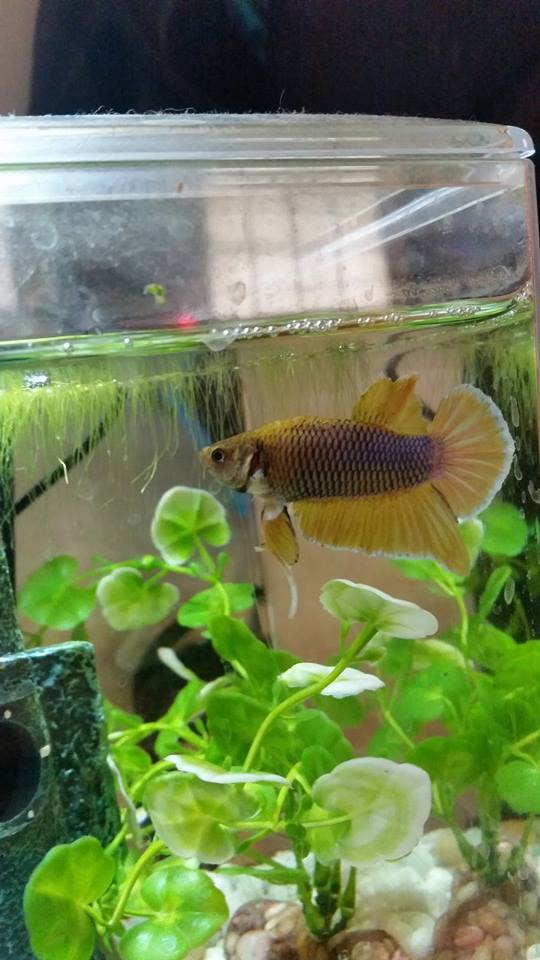
Also, Kaiju got sand and a lid and his tank looked no longer super awful except it turned out the sand I got was too fine and developed some wicked anaerobic bacteria smell and it was awful. I replaced it with black sand within a few months lol

Age 20, Junior Year 2014-15
So I went back to school with three fish, plus Kenway who I took back not long after coming back. Michael passed in September and not long after, I got my first female betta, Wyn.
These were my tanks at this point:
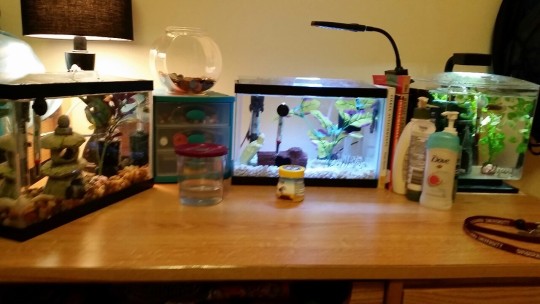

And Wyn, when I first got her:
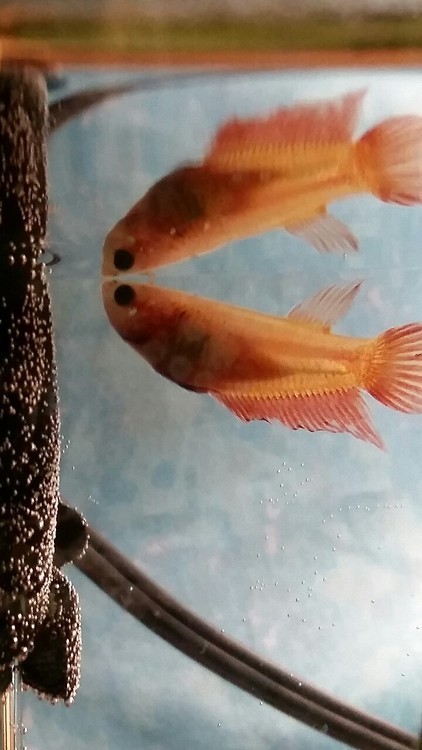
Divided 10, January 2015
So I found a $5 ten gallon at Good Will over winter break and divided Wyn and Odyssey (which was dumb) with a DIY mesh divider (which was not safe) and lit it with an under cabinet light ducktaped to the wall (which looked hideous holy shit)

Second divided 10 gallon
Found a $15 10 gallon with an Aquaclear filter (my first HOB) and a hood so I upgraded Kenway and Kaiju to an equally unsafe and ugly divided 10 but at least it was slightly less ugly.


Then, that summer I took all my fish on an 8 hour road trip to NJ to be babysat by roommate while I was in Europe? I’m not sure why that was necessary but ok
First single betta 10 gallon, July 2015
About a month after returning from Europe, Odyssey unfortunately passed away. I decided to keep Wyn by herself in the 10 gallon because she loved the space so much. And I got an actual light. Wyn had grown into a beautiful lady fish and she was the best and most precious thing in the world to me.

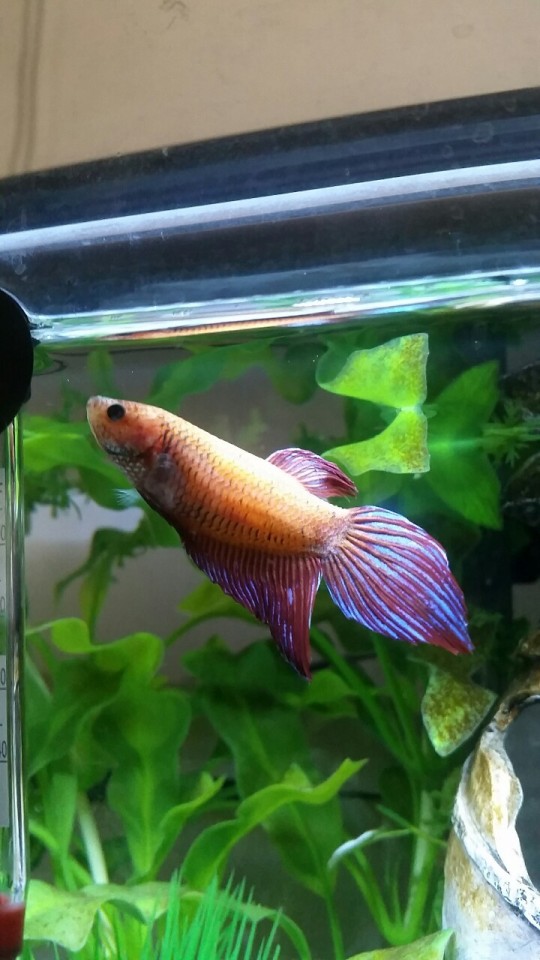
No more divided tanks, Octoberish 2015 idk
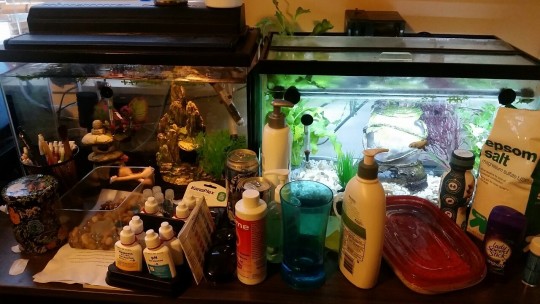
Kaiju developed a tumor sometime in the beginning of my senior year of college and as his swimming began to deteriorate, I moved him into his own 10 gallon. Despite his tumor, he actually outlived Wyn, who passed unexpectedly after a year and one month with her.
Kaiju just before I put him to sleep:
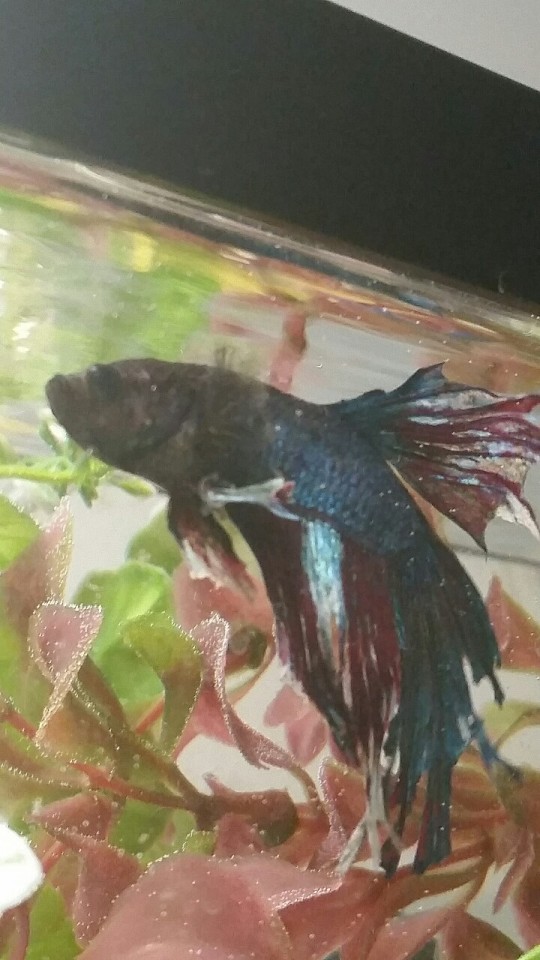
And my Wyn’s resting place:

I cried for days after Wyn passed and didn’t really want much to do with the hobby. I still had Kenway but mostly just maintained his tank and didn’t do much with him. He was pretty slowed down by his big fins and was going blind.
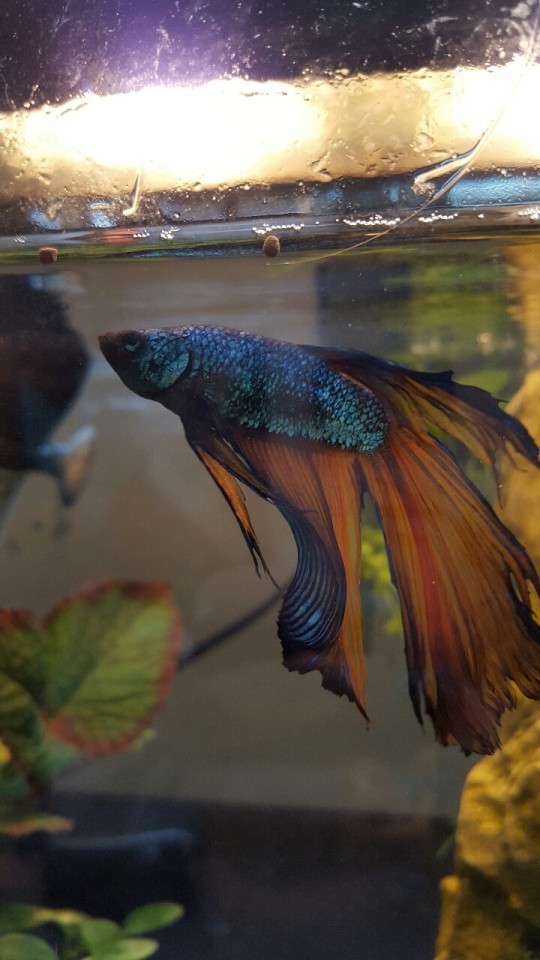
Age 21, February 2016
After a few months, I brought home Durriyah, a new lady betta and put her in a HIDEOUS 10 gallon by herself ft. return of the awful blue gravel


Age 22, still 2016
I graduated and came home with two bettas in 10 gallon tanks. Towards the end of the summer, Kenway passed away, and I got Zazzle. And then a month later impulse bought Buzz and set up the third 10 gallon and got a rack. My ability to not make tanks look like garbage had improved significantly.
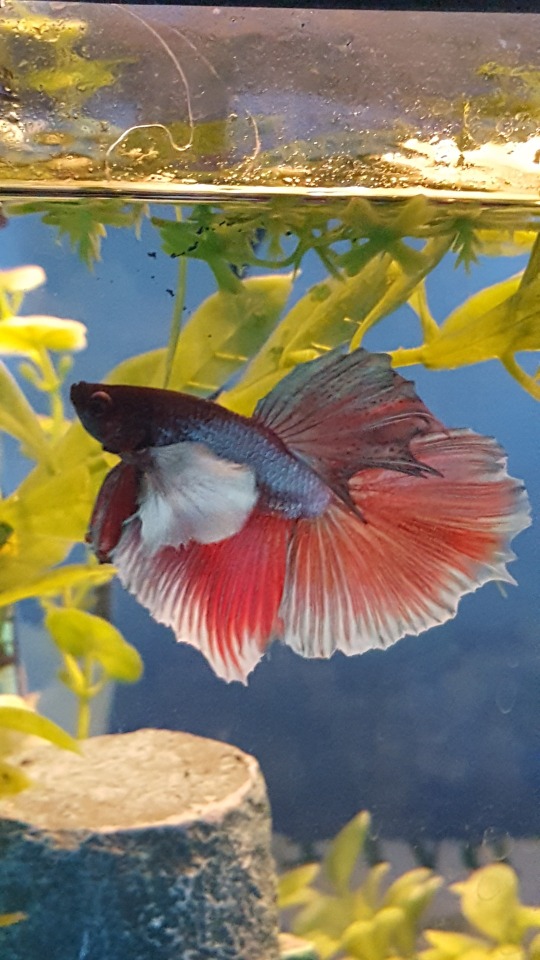
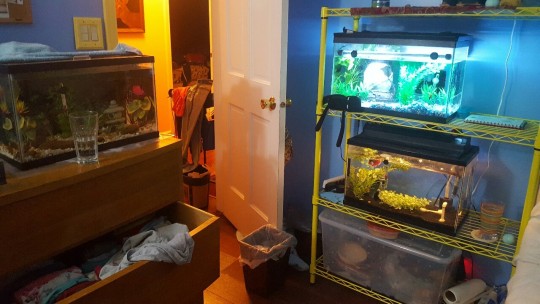

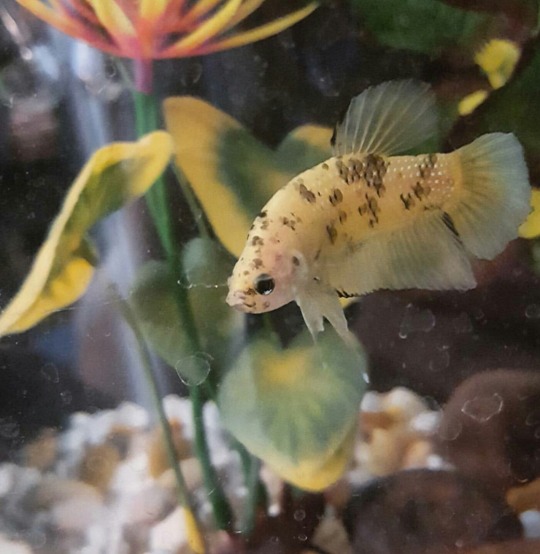
March 2017, Planted, Community Tank and Exponential Tank Increase Begins
So this is getting long as fuck but ok, in March I got ~employed~ so decided I had money for trying out planted tanks. Bad mistake, 10/10 do not recommend for the sake of your wallet. I also got into a bunch of fish Youtubers and tried out some DIY shit and became way more present in fishblr but also branched out more

I also added a small school of 8 ember tetras in my 10 gallon tank with Zazzle

They did pretty well together!
One month later (after some rearranging and some plant death)

20gal community, May?? Idk what is time
So then the next big fish thing was my decision to upgrade the planted 10 to a 20 and start an actual tropical community.
Planted 20 when first set up:
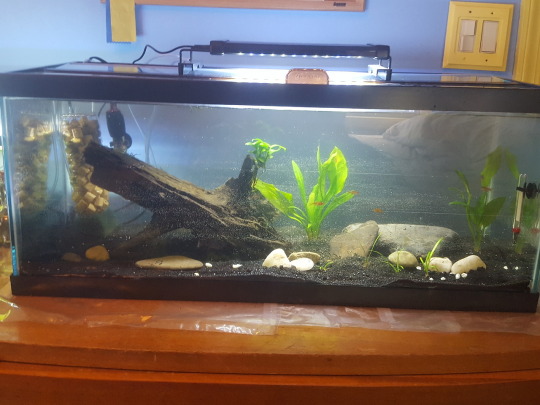
Most recent picture of the planted 20 ft. dwarf gourami, harlequin rasboras, ember tetras, and horned nerites. I am very proud of this tank today and though I’m currently dealing with some illness and lots of algae, it is eons better than my beginnings.

Some other stuff happened with my tanks within there but all that feels too recent to really talk about. Currently I have six bettas and 8 tanks overall. I continue to learn constantly, especially about plants, filtration, and fish illness. My fish opinions have changed SO MUCH since I was a wee baby betta blog back in 2014 it’s ridiculous... and I thought I knew shit back then and would attempt to give advice like a dumbass.
Important fish thing to remember: you are ALWAYS LEARNING ALWAYS. There is always something you don’t know or haven’t encountered. Most of the advice you’ve heard/give others will turn out to be bogus. RESEARCH ALWAYS.
And it’s also ok if your tanks are hideous because pretty tanks can be very very expensive and I feel you, I was cheap as fuck for a long time. Your fish doesn’t care that you have rainbow puke gravel and ugly tattered plants. Your fish just want food and clean water and not much else.
Take risks, do your research, and branch out. Keep what you love, not what other people love. My favorite tank by far is my snail tank full of pest snails lol My favorite fish is my ugly, plain looking female who hides 99% of the time. I have been keeping fish for over four years and have made MANY mistakes and had a lot of ugly tanks and setbacks and times I almost quit.
I have spilled a lot of water on stuff I shouldn’t have spilled water on. I have ended up with lots of sand in my bed and on my floor. I have gone through more towels than you can believe and blown a lot A LOT of money on nice pieces of wood and weird sponges and rocks. I can no longer sleep without the sound of a whole bunch of air pumps and filters. I wouldn’t trade any of it, even though I started off a bit rocky and almost quit after losing Wyn and would have way more surfaces and more money if I didn’t have fish. I can’t even imagine it though. My fish got me through a bunch of rough patches in college and tank maintenance has both caused me a lot of stress and eased my anxiety at the same time.
Whew this is long please do not read this whole thing lawd
39 notes
·
View notes
Text
What is Truly Happening with Personalized Pet Pillows
What is Really Going on with Personalized Pet Pillows
Your pet quilt might be knitted, woven or fleece, depending on the effect and sort of fabric you would like. Consider the way you live, too, when you choose a fabric. Durable fabrics are usually woven tightly. Better not tread the path of deciding upon the incorrect fabric, especially whenever you're priggishly punctilious! Linen is utilized in every form of decorating application, based on the kind of fabric it's made into. Now you own a bedding including Bambi!

Our polyester neck cushions come in a wide variety of colours, so that you may match your airline emblem which have any of the shades we offer. As stated by the spokesperson of the internet shop, these pillows are handmade and they take an additional attention to customize each pillow they ship to their clients. All these pillows are created from quality materials which will also supply the required comfort and relaxation. You may come across this specific pillow on Zazzle. Our personalized pillows are a really good means to get you started! These custom-made pet pillows are offered at affordable rates and one can also obtain limited time free delivery for placing an order with the internet shop. personalized pet pillows made from silk has to be dry cleaned.
When you're discussing photo blankets, there are many styles you may pick from. It is possible to weave your blankets that could display the photos that you wish to display, and for that you've got all kinds of photos with photo blankets. These personalized picture blankets are in fact made out of photos.
The Definitive Strategy to Personalized Pet Pillows
The very first thing you are going to want to do is think about what color and kind of fabric you need to use. Make certain that if you're using 3 unique colours, that the strips wind up in the same (color) order since they were when you began braiding. There are plenty of colours and manners of carousel horse murals for sale. It is going to surely look special with a unique picture engraved in the blanket and you'll also get a chance to talk about your unspoken word in a special way. An especially attractive photo of our dogs is something which ought to be displayed, and a dog picture blanket is a good way to proclaim your love in their opinion.
If You Read Nothing Else Today, Read This Report on Personalized Pet Pillows
Horses can be found in many styles and sizes. The horse is currently ready for accents. Additionally, it's ideal to be certain the dog is friendly and can handle being in a massive crowd. There are several methods to remember our pets. Whenever you have pets in your home, then flea infestation in the home is a typical occurrence. Hello Kitty is among the best friends for a small girl, now she is able to sleep underneath the bedding of hello Kitty!
Who Else Wants to Learn About Personalized Pet Pillows?
When selecting a gift, be certain it is safe. You're best to purchase a gift with your co-workers. Gifts never need to be material. Doggy gifts aren't only for canines. As you most likely have deduced, selecting corporate gifts isn't a specific science. You need to ensure you give an ideal gift in the suitable budget. It is a superb present for a person who likes to write, or who's very reflective.
0 notes
Link
NEW YORK, United States — You may have noticed them. On city streets, on high school campuses, and, more often than not, on Instagram: young people wearing t-shirts emblazoned with oversize block lettering on the chest, the back or running up the sleeves. “I Feel Like Pablo” or “Bigger Than Satan” or “Summer Sixteen”, the shirts read. Or, rather, announce. It’s a fashion statement and also a coded advertisement for their pop-cultural allegiances. It’s “merch”, and it’s everywhere.
The once lowly art of selling branded merchandise inside concert venues has become its own fashion-adjacent industry with numerous sub-categories. Musicians including Justin Bieber, Drake, Zayn Malik and Kanye West each offer promotional clothing lines that mimic the swaggering energy of streetwear and skate brands, while high-end labels including Vetements and Gucci playfully adopt the aesthetic to ironic effect. You can now find merch at fast fashion favourites including H&M and Zara. Media brands are even creating their own merchandise, from The New York Times to the indie magazine 032c and fashion-news website Fashionista. And so are religious organisations, most notably the Los Angeles-based Zoe Church, where influencers including Justin Bieber and model Hailey Baldwin attend events and services.
The significance of this moment in fashion can be felt in the way such influencers have embraced, and evolved, the merch movement. See: Miroslava Duma sporting a Google baseball cap, or Rihanna’s meta take on the trend, when she wore a shirt featuring herself wearing an “I’m with Her” Hillary Clinton T-shirt during last year’s election.
Of course, commercial merchandise is nothing new. Concert tees have long served a starring role in the wardrobes of certain style tribes, with fans of Metallica, the Rolling Stones and the Grateful Dead wearing those items as regularly as a fashion fan dons a pair of Gucci loafers. And it has also always been a big business. In 1998, popular American group the Dave Matthews Band reportedly brought in $200,000 a day through merchandise sales alone. Pulling back, the numbers on the broader merch category are impressive. The global market for promotional products reached more than $21 billion in sales in 2016, up more than 2 percent from the year previous, according to trade organisation Promotional Products Association International. More than a third of those sales came from "wearables" — i.e., t-shirts, caps, jackets, etc.
For today’s consumer especially, merch is not just about associating oneself with a certain artist or tribe; it’s about associating oneself with the height of fashion. Consider Justin Bieber’s merchandising strategy during his 2016 tour. First, he offered the merch at his own concerts. Next, it was available at Barneys New Yorkand then, finally, for the masses at Forever 21. (It should be noted that Bieber’s line was made in collaboration with designer Jerry Lorenzo of the well-regarded label Fear of God, giving it an extra whiff of street cred.)
The result? Influencers and editors who got hold of the street-style bait early on wore the hoodies and t-shirts all over Instagram. Those posts essentially served as free advertising for when the products finally hit the floor at Forever 21.
Merch represents the way in which fashion has become inexorably tied with pop culture, yes, but it also underscores the use of social media platforms like Instagram to visually express one’s values.
The movement has been financially fruitful as well. Bravado, the licensing division of Universal Music Group that handles Justin Bieber’s branded apparel amongst others, has seen significant growth. According to Variety, Bravado reported growth of 13 percent during its first-quarter earnings this year.
Last year, Vetements chief executive Guram Gvasalia told the New York Times that sales of its merch-driven line reached eight figures in just three years. Luxury conglomerate Kering called out Balenciaga's “excellent” performance — in part thanks to creative director Demna Gvasalia’s elevated take on merch for the house — as a reason for an 11.1 percent rise in revenue for its portfolio during the first quarter of its 2017 fiscal year. Dior creative director Maria Grazia Chiuri garnered much press for the graphic t-shirts she showed during her spring 2017 show, which read “We Should All Be Feminists”. The bold statement was a risk that paid off. The shirts, which cost $710, sold out quickly — the proceeds of which went to charity — all of which helped fuel a 17 percent rise in sales at the house in the first quarter of this year.
You don’t want to saturate the market, experience a backlash and kill the brand. People get bored very easily nowadays.
For the fashion industry, the merch movement is a welcome antidote to a general consumer shift away from collecting things to collecting experiences. However, as with any trend, the block-letter look will eventually tire as consumers grow exhausted spending hundreds of dollars on screen-printed t-shirts. Therein lies the question: When will we reach peak merch?
“Merch fashion lines for artists will certainly carry and evolve,” says Sara Maggioni, director of retail and buying at the trend forecasting firm WGSN. “There’s too much money in it for them not to do it — for a little while, at least.” If anything, she says, the rise of merch has proven just how much the general public will buy into this type of branding, and clothing is just the beginning. “Supreme has already started to brand everything, from bricks to NYC metro cards, so anything can happen.”
“However, I do think that moderation is key,” Maggioni adds. “You don’t want to saturate the market, experience a sudden backlash and essentially kill the brand,” noting that even the beloved Supreme has gained detractors of late. “People get bored very easily nowadays.”
New approaches indicate that merch 2.0 could include deeper, more symbiotic partnerships between brands and celebrities. For example, Helmut Lang has tapped hip-hop artist Travis Scott for a collaborative capsule collection that, in theory, represents the ethos of both musician and fashion label. Bravado recently unveiled a collection created with the Los Angeles boutique Maxfield and the rock band Guns n’ Roses, featuring a “curated collection” using the band’s iconography but reinterpreted by Off-White’s Virgil Abloh and Palm Angels’ Francesco Ragazzi, and others. Forever 21 announced a collaboration with musician Future and streetwear label Cease & Desist.
Consumers are also developing their own merch, feeding into the remix culture so prevalent today in younger generations. Because there are no minimums for customisation today thanks to advancements in software and digital printing technology, small runs of personalised product can easily be made and distributed. Anything could be considered merch, from a t-shirt printed with one’s declarations on the President to beer cozies customised for a bachelorette party.
Consumers express status not just through purchases, but also through their statements and values.
A new wave of indie brands are also capitalising on the trend. Consider the retro graphic T-shirts from Monogram, the popular skate line Bianca Chandon and the flirty embroidered messages at Sporty and Rich, from the social influencer Emily Oberg who now serves as women’s creative lead at the streetwear brand Kith, as prime examples.
The rise of personal merch has equalled financial success for companies like Zazzle, the $300 million Silicon Valley-based customisation platform. Chicago-based custom apparel website Ript Apparel brings in $4 million in revenue annually. Teespring, which has raised $55 million since its founding in 2011, is fuelling small businesses like that of merch maker Benny Hsu, who claimed in 2016 that he was able to make $100,000 in just five months by selling product he manufactures via the customisation website.
Adriana Krasniansky, senior strategist at consultancy PSFK, sees two places the merch trend could go. First, after expressing their personal tastes, consumers may accelerate the ways in which they use clothing as a means of expressing more value-oriented messaging — think of the rise in shirts used as political dispatches in the post-Trump era. “A big thing we’re seeing is consumers express status not just through purchases, but also through their statements and values,” she says.
Krasniansky points to the fact that part of the popularity around merch is its tribal qualities. While merch is currently fashionable, it’s the community connected to it that makes it resonate emotionally. The next step is figuring out how to make those in-real-life experiences translate online. “We’re looking at the activation around merch. The built-in hype, getting people into queues or stores — that’s becoming more digital,” she says. “So we’re thinking about augmented reality: how do you create a pop-up that isn’t a physical pop-up? How do you create that community, like the sneaker line, in a digital space?”
As for longevity, it appears that we’ve not yet hit the trend’s apex. “I think we’re just ramping up,” says Robert Burke, chairman and CEO of Robert Burke Associates. “It hasn’t peaked yet but it’s certainly been prolific.” However, he also notes that the pendulum does swing, and it does so swiftly. “With anything that comes on strong, it also falls off quickly,” he says. “No one has a crystal ball, but I think when it becomes too much, people will start gravitating towards things that are easier on the eye.”
0 notes
Text
This Week in Content Marketing: The New Content Business Model Awaits
PNR: This Old Marketing with Joe Pulizzi and Robert Rose can be found on both iTunes and Stitcher.
In this episode, we do a deep dive into the Pepsi ad fiasco and what might have been the reason for such a spectacular misstep, followed closely by an exploration of Dennis Publishing and how they’ve unlocked the only content business model that matters. Our rants and raves include advertising blinders and smartphone addiction; then we close the show with an example of the week from Farmer-Stockman Insurance.
This week’s show
(Recorded live on April 10, 2017; Length: 1:08:28)
Download this week’s PNR This Old Marketing podcast.
If you enjoy our PNR podcasts, we would love if you would rate it, or post a review, on iTunes.
Today’s episode sponsor (09:28)
PowerPost: Welcome to the Age of Power Publishing: As content marketers, we understand the importance of creating content that not only educates, but also inspires consumers to take action. As a result, we have entered a new era of “brands as publishers” – where brands are increasingly becoming publishers in their own right. With brand publishing and content distribution comes several key steps to the publishing process. But the elongated process of content creation, review, scheduling, and tracking analytics can often take more time than we have. Built by marketers for marketers, PowerPost is a time-saving tool for companies who manage content for multiple brands with multiple users – whether it’s a regulated industry or creative agency. With PowerPost, your team can publish from one location across all of your online platforms, quickly and efficiently turning your brand into a power publisher.
To help more brands excel at publishing, join us for a webinar on May 9th with CMI founder Joe Pulizzi. We have also created a comprehensive e-book, with insights from 50 experts in the content marketing field, and their strategies on conquering the five pillars of brand publishing: content planning, workflow, distribution, analytics, conversion. Claim your download at powerpost.digital.
1. Notable news and upcoming trends:
Anatomy of a content-by-committee failure (12:25): The Boston Globe gives an agonizing, blow-by-blow account of a Pepsi ad that was released (and pulled) last week. The spot, which featured Kardashian step-sibling Kendall Jenner, was pummeled on social media as a tepid and tone-deaf attempt to co-opt the emotion of U.S. political activism movements – like #BlackLivesMatter and the Women’s March – as a means to sell soda. What may have started out as a well-intentioned idea clearly got mangled in execution. Not only did it feel like a total topical mismatch for the normally fun-centric beverage brand, it reminds us of what can happen when the product and the brand get in the way of telling an interesting story. We just hope it won’t keep Pepsi from continuing to take risks.
HANDPICKED RELATED CONTENT: Social Media Mistakes: What Brands Should Do to Avoid Epic Fails
How Dennis Publishing’s willingness to pivot underpins its profitability (23:50): theMediaBriefing reports on a U.K. publishing company that is finding success in e-commerce by focusing on high-value transactions, rather than trying to go head-to-head with big players like Amazon. Dennis Publishing, recognized as The British Media Awards’ media company of the year in 2016 has monetized the audience of in-market car buyers it built, by creating an e-commerce site, buyacar.co.uk. As a case study, Dennis Publishing’s business model can teach content marketers a lot – a subject Robert and I talk about, at length, in our upcoming book Killing Marketing.
Zazzle characterizes the state of U.K. content marketing in 2017 (36:48): Zazzle Media has released its latest report, which characterizes key trends and challenges currently facing content marketing practitioners in the U.K. The publication leaves me curious about the demographics that are reflected in the results, since there’s no mention of who participated in the study, the types of companies they work for, or how many respondents there were. Take note: If you create original research and claim to have definitive information related to your industry, you need to be transparent about who and where your data is coming from.
If you create original research, be transparent about who & where data is coming from, says @joepulizzi. Click To Tweet
2. Sponsor (44:44)
Parse.ly – Getting There: How Brands, Publishers, and Agencies Use Content Analytics: With content creation and promotion comes a lot of data. If you have a digital audience, there’s a good chance that you have trouble connecting the information your data provides with a way to use it to improve your content strategy. Don’t worry – you’re not alone. Parse.ly (the company, not the herb) has researched the state of content analytics with a survey of publishers, brands – anyone that creates content. The report it produced on the findings reveals what metrics the industry considers most useful, the siloed state of brand and publisher offices when it comes to data access, and how their analytics end up impacting the content they create. Get it now.
3. Rants and raves (47:16)
Robert’s rant: Robert came across an article in AdAge, in which agency holding company IPG’s Chairman-CEO, Michael Roth, derides the motivations and abilities of consulting companies, claiming that they don’t have what it takes to come up with iconic creative campaigns. Robert takes issue with his assertions; having plenty of experience with business transformations that have resulted from these types of trusted partnerships, Robert warns that anyone underestimating the skill and creativity of consultant groups should do so at their own peril.
Anyone underestimating the skill & creativity of consultant groups does so at own peril, says @robert_rose. Click To Tweet
Joe’s rave: I followed a recent story on 60 Minutes, about the impact of smartphones on teens and adults, from the broadcast to the CBS News site, where I found a fountain of useful information on smartphone and app addiction. As segment correspondent Anderson Cooper discusses, the goal of engineers at app companies and smartphone manufacturers is to get consumers hooked on checking their devices more and more frequently – and they are doing it in some surprising and sneaky ways. Cooper is quickly becoming the network’s go-to media expert on the subject, and if you have some time to spare, I encourage you to check out a few of his other conversations on the topic.
4. This Old Marketing example of the week (59:57)
This week, we have a story that may not fit our typical This Old Marketing mold, but it has too many interesting twists, turns, and connections to content marketing for us to ignore: Robert came across an article in The Spokesman-Review from 1996, which talks about the sale of a portfolio of agricultural magazines to Chicago-based Farm Progress Companies Inc. At the time of the sale, Farm Progress already owned a publication called Prairie Farmer, which has been published consistently since the late 19th century (making it the oldest magazine in the U.S.). The first twist in the story is that Prairie Farmer is now owned by Penton Media – the company I left to form Content Marketing Institute. The second is that the seller, Northwest Farmer-Stockman Inc. began the publication, not as a way to generate advertising revenue, but rather as a way to enter the insurance business. The company’s pivot began in the 1980s, when it started using its agricultural magazines to offer up specialized insurance for farmers, based on its in-depth understanding of its audience’s needs and interests. But what makes this a truly remarkable example of This Old Marketing is that, as part of the company’s original deal with Farmer’s Progress, the company would retain exclusive rights to provide insurance services to subscribers for a period of 20 years after the sale. If you visit the Farmer-Stockman site today, you’ll see that it still operates as an insurance company, and it continues to position itself as the only insurance and financial service organization recommended to subscribers of multiple farmer’s magazines – including many that hadn’t been part of the Farmer’s Progress deal.
Image source
For a full list of PNR archives, go to the main This Old Marketing page.
Cover image by Joseph Kalinowski/Content Marketing Institute
How do I subscribe?
The post This Week in Content Marketing: The New Content Business Model Awaits appeared first on Content Marketing Institute.
This Week in Content Marketing: The New Content Business Model Awaits syndicated from http://ift.tt/2maPRjm
0 notes
Text
This Week in Content Marketing: The New Content Business Model Awaits
PNR: This Old Marketing with Joe Pulizzi and Robert Rose can be found on both iTunes and Stitcher.
In this episode, we do a deep dive into the Pepsi ad fiasco and what might have been the reason for such a spectacular misstep, followed closely by an exploration of Dennis Publishing and how they’ve unlocked the only content business model that matters. Our rants and raves include advertising blinders and smartphone addiction; then we close the show with an example of the week from Farmer-Stockman Insurance.
This week’s show
(Recorded live on April 10, 2017; Length: 1:08:28)
Download this week’s PNR This Old Marketing podcast.
If you enjoy our PNR podcasts, we would love if you would rate it, or post a review, on iTunes.
Today’s episode sponsor (09:28)
PowerPost: Welcome to the Age of Power Publishing: As content marketers, we understand the importance of creating content that not only educates, but also inspires consumers to take action. As a result, we have entered a new era of “brands as publishers” – where brands are increasingly becoming publishers in their own right. With brand publishing and content distribution comes several key steps to the publishing process. But the elongated process of content creation, review, scheduling, and tracking analytics can often take more time than we have. Built by marketers for marketers, PowerPost is a time-saving tool for companies who manage content for multiple brands with multiple users – whether it’s a regulated industry or creative agency. With PowerPost, your team can publish from one location across all of your online platforms, quickly and efficiently turning your brand into a power publisher.
To help more brands excel at publishing, join us for a webinar on May 9th with CMI founder Joe Pulizzi. We have also created a comprehensive e-book, with insights from 50 experts in the content marketing field, and their strategies on conquering the five pillars of brand publishing: content planning, workflow, distribution, analytics, conversion. Claim your download at powerpost.digital.
1. Notable news and upcoming trends:
Anatomy of a content-by-committee failure (12:25): The Boston Globe gives an agonizing, blow-by-blow account of a Pepsi ad that was released (and pulled) last week. The spot, which featured Kardashian step-sibling Kendall Jenner, was pummeled on social media as a tepid and tone-deaf attempt to co-opt the emotion of U.S. political activism movements – like #BlackLivesMatter and the Women’s March – as a means to sell soda. What may have started out as a well-intentioned idea clearly got mangled in execution. Not only did it feel like a total topical mismatch for the normally fun-centric beverage brand, it reminds us of what can happen when the product and the brand get in the way of telling an interesting story. We just hope it won’t keep Pepsi from continuing to take risks.
HANDPICKED RELATED CONTENT: Social Media Mistakes: What Brands Should Do to Avoid Epic Fails
How Dennis Publishing’s willingness to pivot underpins its profitability (23:50): theMediaBriefing reports on a U.K. publishing company that is finding success in e-commerce by focusing on high-value transactions, rather than trying to go head-to-head with big players like Amazon. Dennis Publishing, recognized as The British Media Awards’ media company of the year in 2016 has monetized the audience of in-market car buyers it built, by creating an e-commerce site, buyacar.co.uk. As a case study, Dennis Publishing’s business model can teach content marketers a lot – a subject Robert and I talk about, at length, in our upcoming book Killing Marketing.
Zazzle characterizes the state of U.K. content marketing in 2017 (36:48): Zazzle Media has released its latest report, which characterizes key trends and challenges currently facing content marketing practitioners in the U.K. The publication leaves me curious about the demographics that are reflected in the results, since there’s no mention of who participated in the study, the types of companies they work for, or how many respondents there were. Take note: If you create original research and claim to have definitive information related to your industry, you need to be transparent about who and where your data is coming from.
If you create original research, be transparent about who & where data is coming from, says @joepulizzi. Click To Tweet
2. Sponsor (44:44)
Parse.ly – Getting There: How Brands, Publishers, and Agencies Use Content Analytics: With content creation and promotion comes a lot of data. If you have a digital audience, there’s a good chance that you have trouble connecting the information your data provides with a way to use it to improve your content strategy. Don’t worry – you’re not alone. Parse.ly (the company, not the herb) has researched the state of content analytics with a survey of publishers, brands – anyone that creates content. The report it produced on the findings reveals what metrics the industry considers most useful, the siloed state of brand and publisher offices when it comes to data access, and how their analytics end up impacting the content they create. Get it now.
3. Rants and raves (47:16)
Robert’s rant: Robert came across an article in AdAge, in which agency holding company IPG’s Chairman-CEO, Michael Roth, derides the motivations and abilities of consulting companies, claiming that they don’t have what it takes to come up with iconic creative campaigns. Robert takes issue with his assertions; having plenty of experience with business transformations that have resulted from these types of trusted partnerships, Robert warns that anyone underestimating the skill and creativity of consultant groups should do so at their own peril.
Anyone underestimating the skill & creativity of consultant groups does so at own peril, says @robert_rose. Click To Tweet
Joe’s rave: I followed a recent story on 60 Minutes, about the impact of smartphones on teens and adults, from the broadcast to the CBS News site, where I found a fountain of useful information on smartphone and app addiction. As segment correspondent Anderson Cooper discusses, the goal of engineers at app companies and smartphone manufacturers is to get consumers hooked on checking their devices more and more frequently – and they are doing it in some surprising and sneaky ways. Cooper is quickly becoming the network’s go-to media expert on the subject, and if you have some time to spare, I encourage you to check out a few of his other conversations on the topic.
4. This Old Marketing example of the week (59:57)
This week, we have a story that may not fit our typical This Old Marketing mold, but it has too many interesting twists, turns, and connections to content marketing for us to ignore: Robert came across an article in The Spokesman-Review from 1996, which talks about the sale of a portfolio of agricultural magazines to Chicago-based Farm Progress Companies Inc. At the time of the sale, Farm Progress already owned a publication called Prairie Farmer, which has been published consistently since the late 19th century (making it the oldest magazine in the U.S.). The first twist in the story is that Prairie Farmer is now owned by Penton Media – the company I left to form Content Marketing Institute. The second is that the seller, Northwest Farmer-Stockman Inc. began the publication, not as a way to generate advertising revenue, but rather as a way to enter the insurance business. The company’s pivot began in the 1980s, when it started using its agricultural magazines to offer up specialized insurance for farmers, based on its in-depth understanding of its audience’s needs and interests. But what makes this a truly remarkable example of This Old Marketing is that, as part of the company’s original deal with Farmer’s Progress, the company would retain exclusive rights to provide insurance services to subscribers for a period of 20 years after the sale. If you visit the Farmer-Stockman site today, you’ll see that it still operates as an insurance company, and it continues to position itself as the only insurance and financial service organization recommended to subscribers of multiple farmer’s magazines – including many that hadn’t been part of the Farmer’s Progress deal.
Image source
For a full list of PNR archives, go to the main This Old Marketing page.
Cover image by Joseph Kalinowski/Content Marketing Institute
How do I subscribe?
The post This Week in Content Marketing: The New Content Business Model Awaits appeared first on Content Marketing Institute.
from http://contentmarketinginstitute.com/2017/04/new-content-business-model/
0 notes